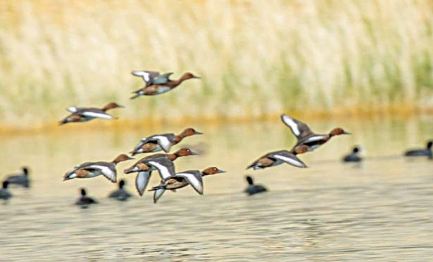PESHAWAR, NOV 05 (APP/DNA): As the golden hues of autumn fade and a chill settles across Pakistan, a familiar rhythm returns to the skies of Khyber Pakthunkhwa where flutter of wings and songs of air travelers attract many.
With the start of November, thousands of migratory birds embark on a perilous journey from the frozen landscapes of Central Asia and Siberia, finding sanctuary in the wetlands, deserts, and forests of Pakistan.
This annual migration, a centuries-old spectacle, transforms Pakistan into a living mosaic of colour and sound, which is a known sanctuary for houbara bustards, cranes, ducks, geese, and countless other species seeking refuge from the bitter northern cold and thrive here.
“Pakistan lies at the crossroads of the great Indus Flyway,” explained Dr. Mumtaz Malik, former Chief Conservator of Wildlife while talking to APP on Wednesday. “From the snow-capped mountains of the Karakoram and Hindu Kush of Chitral, Dir, Khyber Kohat and DI Khan, these birds follow the Indus River down to the plains of Sindh, stopping in wetlands and arid zones along the way.”
The country’s expanding forest cover and increasing wildlife habitats have made it an ideal destination for these seasonal visitors. Wetlands in Khyber Pakhtunkhwa, Punjab, Sindh, and Balochistan now host vast flocks of birds including pintails, mallards, teals, pelicans, cranes, and the elusive houbara bustard which is both revered and endangered.
Among these feathered guests, the houbara bustard holds a special place for falconers. Known for its graceful gait and shy demeanor, the houbara travels in disciplined flocks led by a “chieftain,” Dr. Mumtaz Malik said. “If the leader perishes, the deputy takes charge and guides the group to safety. Their sense of community is remarkable.”
However, the houbara’s existence is fraught with peril. Sensitive by nature, it avoids routes where danger has once been sensed, sometimes changing its traditional paths altogether. The bird feeds on insects, wild fruits, and small reptiles which are all abundant in Pakistan’s arid zones like Dera Ismail Khan, Rahim Yar Khan, and Cholistan.
But its fragility extends beyond migration, he said, adding “A houbara lays just two eggs, and often the first chick kills the second.” “It can take up to five years for a houbara to find a new mate if one is lost.”
Despite conservation efforts, these majestic visitors face growing threats. Illegal hunting and poaching remain widespread, while climate change continues to shrink wetlands and breeding grounds.
“The rivalry between siblings, poaching, and habitat loss are all pushing populations downward,” said Dr. Mumtaz Malik. “Species like the Siberian crane, white-backed vulture, and saker falcon are now at risk.”
He said over 90 species of wildlife are considered endangered or vulnerable, including the Indus dolphin, Baluchistan bear, and green turtle.
Amid these challenges, there is hope for conservation and protection of migratory birds in Pakistan. Conservation initiatives like the 10 Billion Tree Tsunami Project (BTTP) and the Prime Minister’s Green Pakistan programs are transforming the forests landscape.
Muhammad Ibrahim Khan, Deputy Project Director of 10 BTTP, said, “With expanding forest cover, the frequency of migratory birds has increased manifold. New forests like Ghari Chandan in Peshawar and DI Khan have become thriving breeding grounds for migratory birds.”
National parks from Saiful Maluk to Ayubia and Chitral Gol are now central to Pakistan’s wildlife protection strategy.

















